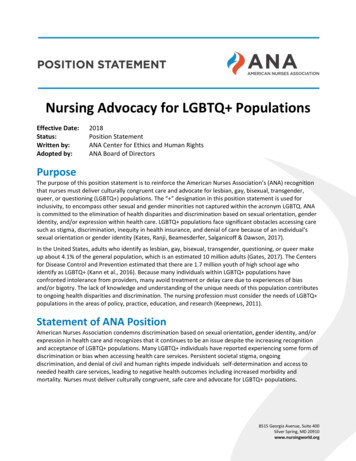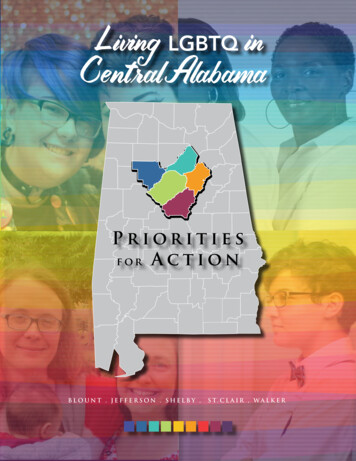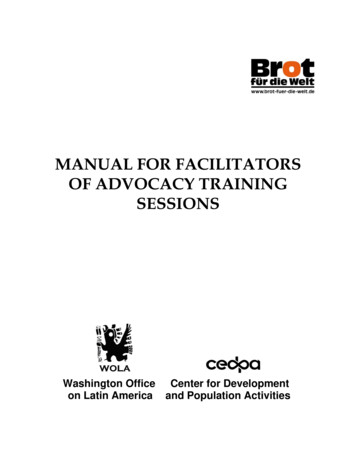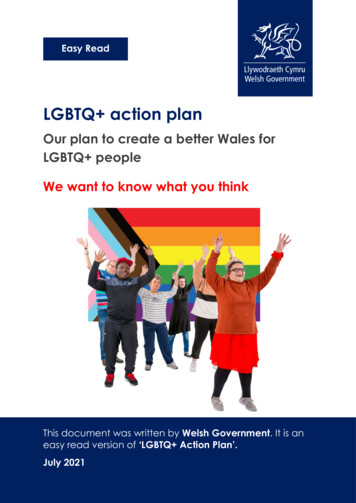
Transcription
Nursing Advocacy for LGBTQ PopulationsEffective Date:Status:Written by:Adopted by:2018Position StatementANA Center for Ethics and Human RightsANA Board of DirectorsPurposeThe purpose of this position statement is to reinforce the American Nurses Association’s (ANA) recognitionthat nurses must deliver culturally congruent care and advocate for lesbian, gay, bisexual, transgender,queer, or questioning (LGBTQ ) populations. The “ ” designation in this position statement is used forinclusivity, to encompass other sexual and gender minorities not captured within the acronym LGBTQ. ANAis committed to the elimination of health disparities and discrimination based on sexual orientation, genderidentity, and/or expression within health care. LGBTQ populations face significant obstacles accessing caresuch as stigma, discrimination, inequity in health insurance, and denial of care because of an individual’ssexual orientation or gender identity (Kates, Ranji, Beamesderfer, Salganicoff & Dawson, 2017).In the United States, adults who identify as lesbian, gay, bisexual, transgender, questioning, or queer makeup about 4.1% of the general population, which is an estimated 10 million adults (Gates, 2017). The Centersfor Disease Control and Prevention estimated that there are 1.7 million youth of high school age whoidentify as LGBTQ (Kann et al., 2016). Because many individuals within LGBTQ populations haveconfronted intolerance from providers, many avoid treatment or delay care due to experiences of biasand/or bigotry. The lack of knowledge and understanding of the unique needs of this population contributesto ongoing health disparities and discrimination. The nursing profession must consider the needs of LGBTQ populations in the areas of policy, practice, education, and research (Keepnews, 2011).Statement of ANA PositionAmerican Nurses Association condemns discrimination based on sexual orientation, gender identity, and/orexpression in health care and recognizes that it continues to be an issue despite the increasing recognitionand acceptance of LGBTQ populations. Many LGBTQ individuals have reported experiencing some form ofdiscrimination or bias when accessing health care services. Persistent societal stigma, ongoingdiscrimination, and denial of civil and human rights impede individuals self-determination and access toneeded health care services, leading to negative health outcomes including increased morbidity andmortality. Nurses must deliver culturally congruent, safe care and advocate for LGBTQ populations.8515 Georgia Avenue, Suite 400Silver Spring, MD 20910www.nursingworld.org
Code of Ethics for Nurses with Interpretive StatementsProvision 1 of the Code of Ethics for Nurses with Interpretive Statements (ANA, 2015a) asserts: “The nursepractices with compassion and respect for the inherent dignity, worth, and unique attributes of everyperson” (p. 1). The interpretive statements that accompany this provision affirm that “the need for and rightto health care is universal, transcending all individual differences” (p. 1) and that “nurses consider the needsand respect the values of each person in every professional relationship and setting” (p. 1). Nurses areexpected to lead in the development, dissemination, and implementation of changes in public and healthpolicies that support protection against discrimination due to sexual orientation, gender identity, and/orexpression. The relationship that nurses create with their patients should be one of trust and compassion.Nurses should first identify and then set aside any bias or prejudice in the provision of nursing care.Interpretive Statement 1.2 instructs nurses to consider “factors such as culture, value systems, religious orspiritual beliefs, lifestyle, social support system, sexual orientation, or gender expression, and primarylanguage when planning individual [patient], family and population-centered care” (ANA, 2015a, p. 1).However, these factors must not be used to discriminate or prohibit access to compassionate and highquality care.The nurse-patient relationship is at the core of health care. Nurses practice with compassion and respect forthe human rights of all individuals regardless of sexual orientation, gender identity, and/or expression. Asexpressed in Nursing: Scope and Standards of Practice (ANA, 2015b), nurses are expected to provideculturally congruent, competent, safe, and ethical care to all patients across all settings. Culturally congruentpractice is the application of evidence-informed nursing that is in agreement with the cultural values,beliefs, worldview, and practices of patients and other stakeholders (ANA, 2015b). To demonstrate culturalcongruence and safe practice, nurses must advocate for patient centered treatment, equal access, equalservices, and equal resources for all populations that may be adversely affected by bias or prejudice. Nurseshave an ethical duty to honor and respect the identities, beliefs, values, and decisions of all patients (ANA,2015a).BackgroundThe Vision of Healthy People 2030 is “a society in which all people achieve their full potential for health andwell-being across the lifespan” (Office of Disease Prevention and Health Promotion, 2017, p. 3). This includesthe goal of eradicating health disparities and achieving health equity. To reduce the health disparitiesexperienced by LGBTQ individuals, there is a need for research on the specific health care needs of uniquegroups within LGBTQ populations. Nurses have investigated best practices in the care of LGBTQ elders andcreated guidelines and policies for chief nursing officers, which supports appropriate culturally congruentcare in maternity transgender clients, and knowledge levels of best practices care and curricular inclusion ofLGBTQ populations in nursing faculty and nursing curricula (Echezona-Johnson, 2017; Lim, Brown & Kim,2014; Lim, Johnson & Eliason, 2015; Klotzbaugh & Spencer, 2015; Strong & Folse, 2015; Zelle & Arms, 2015).The U.S. National Library of Medicine (2018) defines health care disparities as the differences in access to oravailability of facilities and services. Researchers have demonstrated that health care disparities areprevalent for those in LGBTQ populations: lack of knowledge on the part of providers in delivering care tothis population, marginalization isolation, and stigma are some of the reasons that access remains an issuefor many LGBTQ clients (Lim, Brown & Kim, 2014). Health status disparities refer to the variation in rates ofdisease occurrence and disabilities between defined population groups. Numerous disparities withinLGBTQ populations exist in relation to disease patterns and behaviors affecting health (SchenckGustafsson, DeCola, Pfaff & Pisetsky, 2012). For example, LGBTQ youth are two to three times more likelyto attempt suicide and are more likely to be homeless than their heterosexual peers (National LGBT HealthEducation Center, n.d.). They are also at higher risk for acquiring HIV and other sexually transmitted diseasesPage 2Nursing Advocacy for LGBTQ Populations8515 Georgia Avenue, Suite 400Silver Spring, MD 20910www.nursingworld.org
(STDs) and are more likely to be bullied (National LGBT, n.d.). Gay men and other men who have sex withmen (MSM) are at higher risk of contracting HIV and STDs, especially among communities of color (NationalLGBT, n.d.). LGBTQ individuals are more likely to smoke; they also have higher rates of alcohol or othersubstance use, depression, and anxiety (National LGBT, n.d.). Elderly LGBTQ individuals face additionalbarriers to health care because of isolation, diminished family support, and reduced availability of socialservices (National LGBT, n.d.). Of approximately 8% of LGBTQ individuals surveyed, nearly 27% oftransgender and gender-nonconforming individuals, and almost 20% of HIV-positive individuals, reportedbeing denied necessary health care (National Women’s Law Center, 2014). Thus, disparities are not causedby one’s sexual identity; rather, sexual orientation-related health discrimination and disadvantages createhealth disparities (Cochran, Björkenstam, & Mays, 2016). The Institute of Medicine has found these healthdisparities to be one of the main gaps in health disparities research (Institute of Medicine of the NationalAcademies, 2011).The National Academy of Medicine (NAM) (formerly Institute of Medicine) convened a committee of expertsto assess current knowledge of the health status, experiences, and unique needs of members of LGBTQ populations, to identify research gaps and opportunities, and to prepare an agenda for National Institutes ofHealth-sponsored research (Institute of Medicine of the National Academies, 2011). The resulting NAMreport recognized the lack of data needed to build a base of evidence about the needs and health concernsof LGBTQ populations. One of the goals of the Healthy People 2020 plan is to “Improve the health, safety,and well-being of lesbian, gay, bisexual, and transgender (LGBT) individuals” (Healthy People 2020, 2014). In2016, the National Institute of Minority Health and Health Disparities officially designated lesbian, gay,bisexual, and transgender populations as populations of focus for health disparity research (Dept. of Healthand Human Services, 2016). The Fenway Institute’s National LGBT Education Center, the research, training,and health policy division of Fenway Health, has identified health disparities such as the prevalence ofHIV/STDs; the high prevalence of tobacco, alcohol, and other substance use; and barriers to health, resultingfrom isolation and lack of social services and culturally competent providers (The Fenway Institute, 2016).The Joint Commission, in its Field Guide, Advancing Effective Communication, Cultural Competence, andPatient- and Family-Centered Care for the LGBT Community (2011), identified practices and strategies tohelp build trust among health care providers and hospitals and LGBTQ patients and families. It providesadditional guidance for making a safe, welcoming, and inclusive health care environment (The JointCommission, 2011).In 2011, the Centers for Medicare & Medicaid Services finalized federal regulations protecting hospitalpatients’ rights to choose their visitors and prohibiting discrimination in visitation based on sexualorientation and gender identity. The guidance supports the rights of patients to designate the person oftheir choice to make medical decisions on their behalf in cases of incapacity, regardless of sexualorientation, gender identity, and/or expression (Centers for Medicare & Medicaid Services, 2011).History/Previous Position StatementsANA first took an official stance against anti-LGBT discrimination in 1978, when its House of Delegates (HOD)adopted a resolution supporting legislation to bar discrimination based on sexual orientation (AmericanNurses Association Convention ’78, 1978). In 1980, the HOD reiterated this position (American NursesAssociation Convention ’80, 1980).With the emergence of the HIV/AIDS epidemic in the 1980s, nurses and nursing organizations responded toprovide and support evidence-informed approaches to combating the epidemic and opposing discriminationagainst people with HIV/AIDS (ANA, 1988, 1992a). Addressing the epidemic—particularly in its early days—required confronting antigay bias in the general population and within the nursing profession.Page 3Nursing Advocacy for LGBTQ Populations8515 Georgia Avenue, Suite 400Silver Spring, MD 20910www.nursingworld.org
In 1992, the ANA House of Delegates voted to oppose policies barring gay and lesbian individuals fromserving in the U.S. military (ANA, 1992b). After the military’s ban on gay and lesbian service members wasmodified into a “don’t ask, don’t tell” policy, ANA supported efforts to repeal that policy (ANA, 2010). Thisban ended in 2016. In 2017, executive attempts to create a ban on transgender individuals serving in themilitary were unsuccessful. ANA again advocated in support of equality and human rights for LGBTQ populations serving in the military (ANA, 2017).The American Academy of Nursing initiated an Expert Panel on LGBTQ Health in 2011 (AAN, n.d.). Since thattime, the Academy has adopted several position statements on LGBTQ health, including Position statement:Employment discrimination based on sexual orientation and gender identity (Expert Panel on LGBTQ Health,2015a), American Academy of Nursing position statement on reparative therapy (Expert Panel on LGBTQHealth, 2015b), and Same-sex partnership rights: Health care decisiomaking and hospital visitation (ExpertPanel on LGBTQ Health, 2015c). Other nursing organizations have adopted positions addressing concernsamong LGBTQ populations, including the International Society for Psychiatric-Mental Health Nurses (2010),the National Association of School Nurses (2017), and the National Student Nurses Association (2016).Recommendations1. ANA supports efforts to defend and protect the human and civil rights of all members of LGBTQ populations.2. ANA advocates for the rights of all members of LGBTQ populations to live, work, study, or serve inthe armed services without discrimination or negative activities, such as bullying, violence, incivility,harassment, or bias.3. ANA affirms the need for nurses in all roles and settings to provide culturally congruent, competent,sensitive, safe, inclusive, and ethical care to members of LGBTQ populations, as well as to beinformed and educated about the provision of culturally competent care.4. ANA condemns any discrimination based on sexual orientation, gender identity, and/or genderexpression in access to or provision of health care.5. ANA advocates for: Patients and families in LGBTQ populations to have equal rights for surrogate decisionmaking, visiting privileges, and access to loved ones when undergoing care or whenhospitalized. Patient information assessment, forms, and other ways of collecting patient demographics(e.g., electronic health records) that use best practice means of collecting sexual orientationand gender identity patient data so that appropriate clinical and culturally sensitive care isprovided and preferred pronouns are used. It is understood that sexual orientation andgender identity patient information should be considered private patient information sharedon a need-to-know basis. Policies and legislation that support equal access to high-quality, culturally congruent healthcare for LGBTQ populations. Research and interventions aimed at improving the health, wellness, and needs of LGBTQ populations, including collection of sexual orientation, gender identity, and/or expression inresearch studies. Nurse educators that will help fill the void in knowledge by incorporating the issues of theLGBTQ populations as part of nursing curriculum.Page 4Nursing Advocacy for LGBTQ Populations8515 Georgia Avenue, Suite 400Silver Spring, MD 20910www.nursingworld.org
Efforts to promote and advocate for public policy that is aimed at improved access toculturally sensitive, high-quality care and treatment of members of LGBTQ populations. Federal funding to continue appropriate research of LGBTQ populations. Making behavioral health services available that specifically address LGBTQ health. The application of ANA’s Code of Ethics for Nurses with Interpretive Statements to ensureunwavering, culturally sensitive, inclusive, unbiased, and nondiscriminatory care of membersof LGBTQ populations. Strategies to educate nurses about the potential impact of personal bias, whether consciousor unconscious, particularly involving the care of LGBTQ populations. Identification of strategies to raise nurses’ competency in addressing the needs of LGBTQ populations. Support for nurses and other health care providers who are bullied or witness others beingbullied or discriminated against. Nursing education that includes population health education about systemic inequality,barriers, patient-specific care, and interventions for LGBTQ populations. Nursing program accreditors and state boards of nursing that approve nursing programcurricula to require inclusion of content on LGBTQ populations, including standardizedgender-neutral terminology and documentation.ReferencesAmerican Academy of Nursing (n.d.). Expert Panel on LGBTQ Health. Retrieved from American Nurses Association. (1988). Personal Heroism, Professional Activism: Nursing and the Battle Against AIDS. KansasCity, MO: ANA.American Nurses Association. (1992a). Compendium of HIV/AIDS Position Statements, Policies, and Documents. Washington,DC: ANA.American Nurses Association. (1992b). Discrimination Against Gays and Lesbians by Military. Washington, DC: ANA.American Nurses Association. (2010). ANA applauds House action to repeal ‘Don’t Ask, Don’t Tell.’ [Press release].American Nurses Association. (2015a). Code of Ethics for Nurses with Interpretive Statements. Silver Spring, MD:http://nursingworld.org/Code-of-ethicsAmerican Nurses Association. (2015b). Nursing: Scope and Standards of Practice 3rd ed. Silver Spring, MD: Nursesbooks.org.American Nurses Association. (2017, July 28). Statement in support of equality and human rights for the LGBTQ community.[Press release]. Retrieved from nd-human-rights-for-the-lgbtq-communityAmerican Nurses Association Convention ’78. (1978). American Journal of Nursing, 78(7), 1231-1246.American Nurses Association Convention ’80. (1980). American Journal of Nursing, 80(7), 1317-1332.Centers for Medicare & Medicaid Services. (Sept. 8, 2011). Medicare steps up enforcement of equal visitation andrepresentation rights in hospitals. Retrieved from .htmlPage 5Nursing Advocacy for LGBTQ Populations8515 Georgia Avenue, Suite 400Silver Spring, MD 20910www.nursingworld.org
Cochran, S. D., Björkenstam, C., & Mays, V. M. (2016). Sexual orientation and all-cause mortality among US adults aged 18 to59 Years, 2001–2011. American Journal of Public Health, 106(5), 918-920.Department of Health and Human Services. (2016). Advancing LGBT Health and Well-being: 2016 Report of the HHS LGBTPolicy Coordinating Committee. Retrieved from t-with-cover.pdfEchezona-Johnson, C. (2017). Evaluation of lesbian, gay, bisexual, and transgender knowledge in basic obstetrical nursingeducation. Nursing Education Perspectives, 38(3), 138-142.Expert Panel on LGBTQ Health. (2015a). American Academy of Nursing. Position statement: Employment discrimination basedon sexual orientation and gender identity. Nursing Outlook, 63(3), 366.doi: t Panel on LGBTQ Health. (2015b). American Academy of Nursing position statement on reparative therapy. NursingOutlook, 63(3), 368. doi: t Panel on LGBTQ Health. (2015c). American Academy of Nursing. Same-sex partnership rights: Health care decisionmaking and hospital visitation. Nursing Outlook, 63(1), 95. doi: https://doi.org/10.1016/j.outlook.2014.12.016The Fenway Institute. (n.d.). The National LGBT health Education Center. Retrieved from , G. (2017). In US, more adults identifying as LGBT. Gallup. Retrieved from on-rises.aspx?g source lgbt&g medium search&g campaign tilesHealthy People 2020. (2014). Lesbian, Gay, Bisexual, and Transgender Health. Retrieved healthInstitute of Medicine of the National Academies. (2011). The health of lesbian, gay, bisexual, and transgender people: Buildinga foundation for better understanding. Retrieved from le.aspxInternational Society of Psychiatric-Mental Health Nurses. (2010). Position Statement on Reparative Therapy. Retrieved ativetherapy.pdfThe Joint Commission. (2011). Advancing effective communication, cultural competence, and patient- and family-centeredcare for the lesbian, gay, bisexual, and transgender (LGBT) Community: A Field Guide. Oakbrook Terrace, IL: The JointCommission. Retrieved from eldGuide WEB LINKED VER.pdfKann, L., Olsen, E., McManus, T., Harris, W., Shanklin, S., Flint, K., Zaza, S. (2016). Sexual Identity, Sex of Sexual Contacts, andHealth-Related Behaviors Among Students in Grades 9–12—United States and Selected Sites, 2015. MMWR SurveillanceSummaries, 65(2-81).Kates, J., Ranji, U., Beamesder, A., Salganicoff, A., & Dawson, L. (August 2017). Health and Access to Care and Coverage forLesbian, Gay, Bisexual, and Transgender Individuals in the U.S. (Issue brief). Kaiser Family Foundation. Retrieved viduals-in-the-USKeepnews, D.M. (2011). Lesbian, gay, bisexual, and transgender health issues and nursing: Moving toward an agenda.Advances in Nursing Science, 34(2), 163-170.Klotzbaugh, R., & Spencer, G. (2015). Cues-to-Action in Initiating Lesbian, Gay, Bisexual, and Transgender-Related PoliciesAmong Magnet Hospital Chief Nursing Officers: A Demographic Assessment. Advances in Nursing Science, 38(2), 110120.Lim, F. A., Brown Jr., D. V., & Kim, S. M. J. (2014). CE: Addressing health care disparities in the lesbian, gay, bisexual, andtransgender population: A review of best practices. AJN The American Journal of Nursing, 114(6), 24-34.Page 6Nursing Advocacy for LGBTQ Populations8515 Georgia Avenue, Suite 400Silver Spring, MD 20910www.nursingworld.org
Lim, F., Johnson, M., & Eliason, M. (2015). A national survey of faculty knowledge, experience, and readiness for teachinglesbian, gay, bisexual, and transgender health in baccalaureate nursing programs. Nursing Education Perspectives, 36(3),144-152.National Association of School Nurses (2017). LGBTQ students: The role of the school nurse. NASN School Nurse, 32(2), 129131. doi:10.1177/1942602X17691482.National LGBT Health Education Center, a program of the Fenway Institute. (n.d.). Providing inclusive services and care forLGBT people: A guide for healthcare staff. Retrieved from arningguide/National Student Nurses Association. (2016). Improving Professional Support and Advocacy for Lesbian, Gay, Bisexual,Transgender, Questioning, Intersex, and Asexual (LGBTQIA) Nurses. Retrieved 6/04/2016-nsna-resolution-lgbtqia.pdfNational Women’s Law Center. (2014, May 21). Health care refusals harm patients: The threat to LGBT people and individualsliving with HIV/AIDS. Retrieved from g-hivaidsOffice of Disease Prevention and Health Promotion. (April, 27, 2017). Secretary’s Advisory Committee on National HealthPromotion and Disease Prevention Objectives for 2030: Recommendations for an Approach to Healthy People 2030.Retrieved -92017 1.pdfSchenck-Gustafsson, K., DeCola, P. R., Pfaff, D. W., & Pisetsky, D. S. (2012). Handbook of Clinical Gender Medicine. Basel,Switzerland: Karger.Strong, K. L., & Folse, V. N. (2015). Assessing undergraduate nursing students' knowledge, attitudes, and cultural competencein caring for lesbian, gay, bisexual, and transgender patients. Journal of Nursing Education, 54(1), 45-49.U.S. National Library of Medicine. (2018). Health services research information central: Health disparities. Retrieved %20Health%20DisparitiesZelle, A., & Arms, T. (2015). Psychosocial effects of health disparities of lesbian, gay, bisexual, and transgender older adults.Journal of Psychosocial Nursing & Mental Health Services, 53(7), 25-30.ANA acknowledges Ethics Advisory Board members Elizabeth Swanson, DNP, MPH, APRN-BC andLinda Olson, PhD, MBA, MSN, RN, NEA-BC, FAAN; and American Academy of Nursing FellowDavid Keepnews, PhD, JD, RN, NEA-BC, FAAN, who contributed to the drafting of this documenton behalf of the ANA Ethics Advisory Board.Page 7Nursing Advocacy for LGBTQ Populations8515 Georgia Avenue, Suite 400Silver Spring, MD 20910www.nursingworld.org
the National Association of School Nurses (2017), and the National Student Nurses Association (2016). Recommendations 1. ANA supports efforts to defend and protect the human and civil rights of all members of LGBTQ populations. 2. ANA advocates for the rights of all members of LGBTQ populations to live, work, study, or serve in










